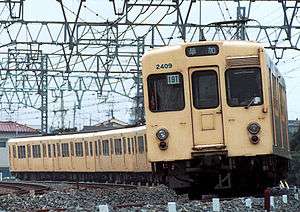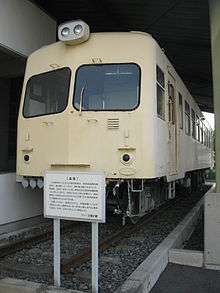Tobu Railway
The Tobu Railway Co., Ltd. (東武鉄道株式会社, Tōbu Tetsudō kabushiki gaisha) is a Japanese commuter railway and keiretsu holding company in the Greater Tokyo Area as well as an intercity and regional operator in the Kantō region. Excluding the Japan Railways Group companies, Tobu's 463.3 km rail system is the second longest in Japan after Kintetsu. It serves large portions of Saitama Prefecture, Gunma Prefecture and Tochigi Prefecture, as well as northern Tokyo and western Chiba Prefecture. The Tobu Railway Company is listed in the First Section of the Tokyo Stock Exchange and is a constituent of the Nikkei 225 index.
 | |
Native name | 東武鉄道株式会社 |
|---|---|
Romanized name | Tōbu Tetsudō kabushiki gaisha |
| Public KK | |
| Traded as |
|
| ISIN | JP3597800006 |
| Industry | Rail-focused conglomerate |
| Founded | November 1897 |
| Founder | Michinari Suenobu Rokuro Hara |
| Headquarters | 2-18-12 Oshiage, Sumida-ku, Tokyo , Japan |
Area served | Tokyo, Saitama, Chiba, Gunma, Tochigi |
Key people | Nezu Kaichirō |
| Services | Passenger railway |
| Total assets | ¥1.3 trillion |
| Owner | Investment trusts (JTSB 6.13%, TMTBJ 4.19%) Fukoku Life (2.47%) SSBTC Treaty 505234 (2.26%) Mizuho Bank (2.20%) |
Number of employees | 4,659 (As of March 2010) |
| Subsidiaries | Various, including the operating company of Tokyo Skytree |
| Website | www |

The Tobu corporate group is also engaged in road transportation (bus/taxi), real estate, and retail. It is the owner of the Tokyo Skytree, the tallest tower in the world. The company is a member of the Mizuho Financial Group, a financial group (keiretsu) and one of the largest companies in the world.
The name "Tobu" is formed from the kanji for east (東) and Musashi (武蔵), the initial area served.
History
Tobu is one of the oldest railway companies in Japan. It was established in November 1897 and began operation between Kita-Senju and Kuki in August 1899. The Tojo Railway was founded in 1911 as a separate company, but shared its president and head office with Tobu.[1]
Tobu was the first railway in the Kanto region to adopt quadruple tracks, on the Kita-Senju to Takenotsuka sector in 1974.[2] The Tobu Dobutsu Koen (Tobu Animal Park) opened in 1981.[3]
Railway network

Tobu has two isolated networks which are connected by the Chichibu Railway for ferrying of its rolling stock.
The Tobu Main Line network has a tree topology starting at Asakusa in Tokyo, with the Isesaki line as the trunk, and the Tobu Kameido Line, Daishi Line, Tobu Urban Park Line, Tobu Sano Line, Koizumi Line, Tōbu Kiryū Line, and Nikkō Line forming the branches, with further branches into the Tobu Utsunomiya Line and Tobu Kinugawa Lines. It offers surcharged, seat-reserved limited express services from Tokyo to Nikkō and Kinugawa.
The Tojo Line runs northwest from Ikebukuro in Tokyo to central and western Saitama Prefecture. A branch, the Ogose Line, runs to Ogose from Sakado.
Tobu's terminals in Tokyo are at Asakusa (Main Line express services), Oshiage (most other Main Line services) and Ikebukuro (Tojo Line). The Skytree and Isesaki Lines interoperate with the Tokyo Metro Hibiya Line to serve central Tokyo, while the Tojo Line interoperates with the Tokyo Metro Fukutoshin Line, Tokyu Toyoko Line and Minatomirai Line to serve central and southwest Tokyo and Kanagawa Prefecture.
Main Lines
| Name | Symbol | Stations | Length (km) |
|---|---|---|---|
| Skytree Line | Asakusa – Tōbu-Dōbutsu-Kōen | 41.0 | |
| Kameido Line | Hikifune – Kameido | 3.4 | |
| Daishi Line | Nishiarai – Daishimae | 1.0 | |
| Isesaki Line | Tōbu-Dōbutsu-Kōen – Isesaki | 75.1 | |
| Sano Line | Tatebayashi – Kuzū | 22.1 | |
| Koizumi Line | Tatebayashi – Nishi-Koizumi, Ōta – Higashi-Koizumi | 12.0 | |
| Kiryū Line | Ōta – Akagi | 20.3 | |
| Nikkō Line | Tōbu-Dōbutsu-Kōen – Tōbu Nikkō | 94.5 | |
| Utsunomiya Line | Shin-Tochigi – Tōbu Utsunomiya | 24.3 | |
| Kinugawa Line | Shimo-Imaichi – Shin-Fujiwara | 16.2 | |
| Urban Park Line (Formerly Noda Line) | Ōmiya – Kasukabe – Funabashi | 62.7 |
Rolling stock
As of 1 April 2016, Tobu Railway operates a fleet of 1,890 electric multiple unit (EMU) vehicles, the third largest fleet for a private railway operator in Japan after Tokyo Metro (2,728 vehicles) and Kintetsu (1,905).[4]
Express EMUs
- 6050 series EMU (introduced 1985)
- 300/350 series EMU (introduced 1991, 300 series variant operated until 2017)
- 200/250 series EMU Ryōmō (introduced 1991)
- 100 series EMU Spacia (introduced 1990)
- 634 series EMU Skytree Train (introduced 2012)
- 500 series 3-car EMUs (introduced in April 2017)
Eight new three-car 500 series EMU trains were introduced on limited express services on lines from Asakusa in 21 April 2017.[5]
- 1800 series
- 350 series Kirifuri limited express
- 634 series Skytree Train
 A 500 series EMU in May 2017
A 500 series EMU in May 2017
Commuter EMUs
- 8000 series EMU (introduced 1963)
- 800/850 series EMU
- 9000 series EMU (introduced 1981)
- 10000 series EMU (introduced 1983)
- 20000 series EMU (introduced 1988)
- 30000 series EMU (introduced 1996)
- 50000 series EMU (introduced 2005)
- 60000 series EMU (introduced June 2013)
- 70000 series EMU (since 7 July 2017)[6]
 30000 series
30000 series 60000 series
60000 series
Steam locomotive
Tobu plans to operate steam-hauled tourist services on the Kinugawa Line from 10 August 2017 using JNR Class C11 steam locomotive C11 207 loaned from JR Hokkaido together with JNR Class DE10 diesel locomotive DE10 1099 purchased from JR East, a fleet of six 12 and 14 series coaches purchased from JR Shikoku, and two Yo 8000 brake vans purchased from JR Freight and JR East.[7]
Withdrawn types
Express EMUs
- 1700/1720 series
- 1800 series
- 5700 series
- 6000 series
 1720 series
1720 series 5700 series
5700 series 6000 series
6000 series
Commuter EMUs
- 2000 series
- 3000 series
- 5000 series (1979–2006)
- 7300 series
- 7800 series
 2000 series
2000 series 3000 series
3000 series- 5000 series
 7300 series
7300 series 7800 series
7800 series
DMUs
- KiHa 2000 series
 Preserved KiHa 2000 series DMU
Preserved KiHa 2000 series DMU
Steam locomotives
- Tobu B1 Class 4-4-0 (1898)
 Preserved Tobu Railway B1 Class 4-4-0
Preserved Tobu Railway B1 Class 4-4-0
References
- Terada, Hirokazu (July 2002). データブック日本の私鉄: 全国私鉄149社局掲載 データブック日本の私鉄 [Databook: Japan's Private Railways]. Japan: Neko Publishing. pp. 56–57. ISBN 978-4-87366-874-1.
- "明治28年~45年". Tobu Railway. Retrieved 28 April 2015.
- "1961年~1980年 | 会社の沿革 | 東武鉄道ポータルサイト". www.tobu.co.jp. Retrieved 2020-03-19.
- "昭和41年~63年". Tobu Railway. Retrieved 28 April 2015.
- 私鉄車両編成表 2016 [Private Railway Rolling Stock Formations - 2016] (in Japanese). Japan: Kotsu Shimbunsha. 25 July 2016. pp. 213–214. ISBN 978-4-330-70116-5.
- 2017年4月21日(金)ダイヤ改正を実施! [Revised timetable to be introduced on Friday 21 April 2017] (PDF). News release (in Japanese). Japan: Tobu Railway. 18 January 2017. Archived from the original (pdf) on 19 January 2017. Retrieved 19 January 2017.
- 東武70000系が営業運転を開始 [Tobu 70000 series enters revenue service]. Japan Railfan Magazine Online (in Japanese). Japan: Koyusha Co., Ltd. 8 July 2017. Archived from the original on 9 July 2017. Retrieved 9 July 2017.
- 東武鬼怒川線で復活するSL「大樹」の営業運転開始日を2017年8月10日(木)に決定! ["Taiju" steam locomotive on Tobu Kinugawa Line to enter service on Thursday 10 August 2017] (PDF). News release (in Japanese). Japan: Tobu Railway. 18 January 2017. Archived from the original (pdf) on 19 January 2017. Retrieved 19 January 2017.
External links
| Wikimedia Commons has media related to Tobu Railway. |
- Tobu Group website (in Japanese)